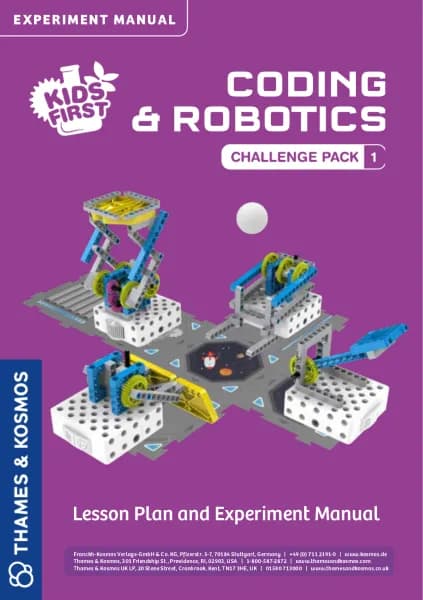Thames & Kosmos Green Engineering: Clean Energy & Sustainable Living handleiding
Handleiding
Je bekijkt pagina 15 van 36

C M
T
Y wT T Ar t bTeE
b tH N iS’t HiNg? shE A SOnG
HAog lP
t sol cL! H
lP St Hi dEcY t sol
cL
Om vY Os DiAn.
EXPERIMENT 1: SOLAR CELL AND BATTERY STATION
1313
Store energy
from the sun
You will need
– Assembled model house
– Direct sunlight
– 3x empty rechargeable 1.2-volt AA batteries
(HR6, NiMH)
Here’s how
1. Before you can charge the batteries
with sunlight, three empty 1.2-volt AA
batteries must be inserted into the battery
station.
Ask an adult to do this for you (see page 4).
2. Find a safe place for the model house where
the solar cell is directly exposed to the sun,
preferably facing south. This could be a
windowsill or a balcony table, for example.
Important: Only place the house outside in
dry, windless weather!
3. Plug the solar cell cable into the M port on
the battery station. The red LED light on
the battery station indicates that it is
successfully charging. If this is not the
case, the sunlight is not strong enough.
Midday sun is best.
4. If you cannot expose the solar cell to direct
sunlight (because it is cloudy, for example),
you can find alternatives in the tip box
below. You can also charge the batteries via
the USB-C port on the battery station (C).
To do this, insert a USB-C cable (not
included) into port C and connect it to a
power source. (Pay attention to the
protective classes on page 2).
2
3
The solar cell supplies the batteries with renewable energy.
The cell is made up of several dierent layers. The top layer
is made silicon, which captures light well. The captured light
contains small particles that carry energy, called photons.
These photons move through the solar cell and hit another
layer that contains electrons — tiny particles in the solar
cell that can carry electricity. When the photons hit the
electrons, the electrons break away from their original
position. The movement of the electrons creates a flow of
current. The more sunlight that hits the solar cell, the more
electricity is generated — that’s why you should face your
solar panel toward the south! This technology is called
photovoltaics. In real houses, the electricity generated by a
photovoltaic system can also be stored in batteries, just like
in your model house.
Energy for Your House
Principles of Photovoltaic
Function
Sunlight
Flow of electrons
Top layer
of silicon
Second layer
of silicon
Transition layer
Photons
Solar cell
E
n
e
r
g
y
W
H
a
’
S
H
p
E
I
n
G
?
Learn how to
green your roof
on page 26!
Bekijk gratis de handleiding van Thames & Kosmos Green Engineering: Clean Energy & Sustainable Living, stel vragen en lees de antwoorden op veelvoorkomende problemen, of gebruik onze assistent om sneller informatie in de handleiding te vinden of uitleg te krijgen over specifieke functies.
Productinformatie
| Merk | Thames & Kosmos |
| Model | Green Engineering: Clean Energy & Sustainable Living |
| Categorie | Niet gecategoriseerd |
| Taal | Nederlands |
| Grootte | 33452 MB |







